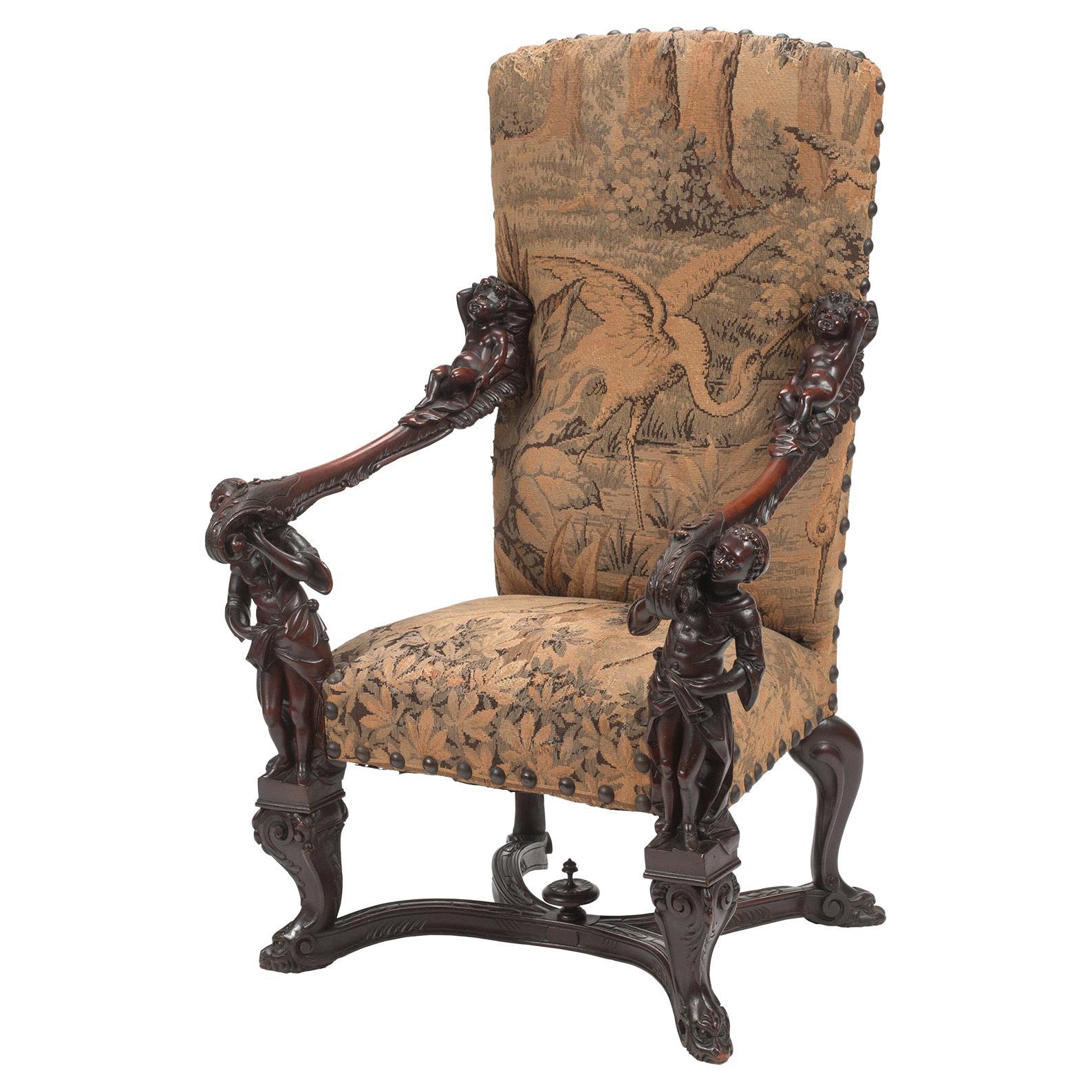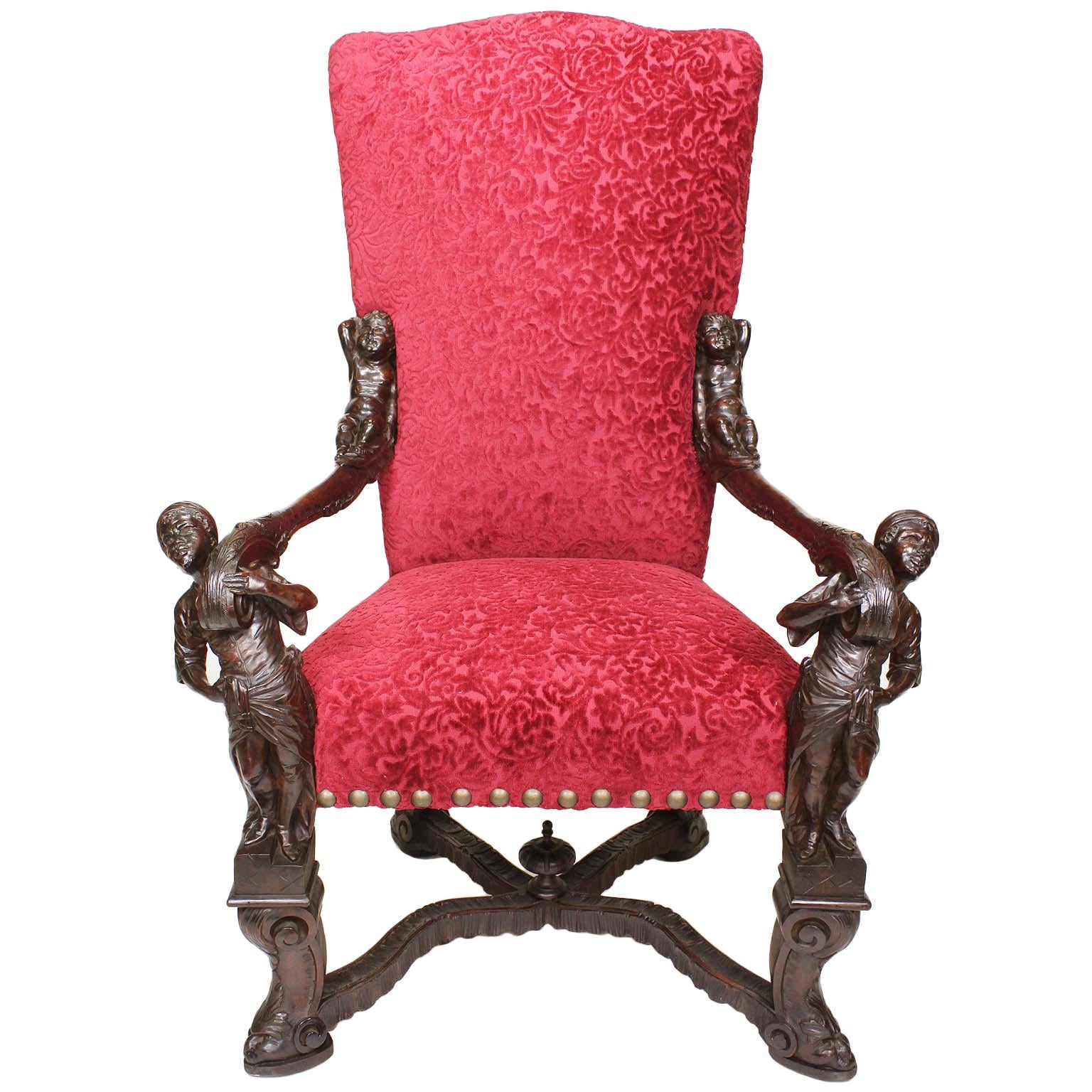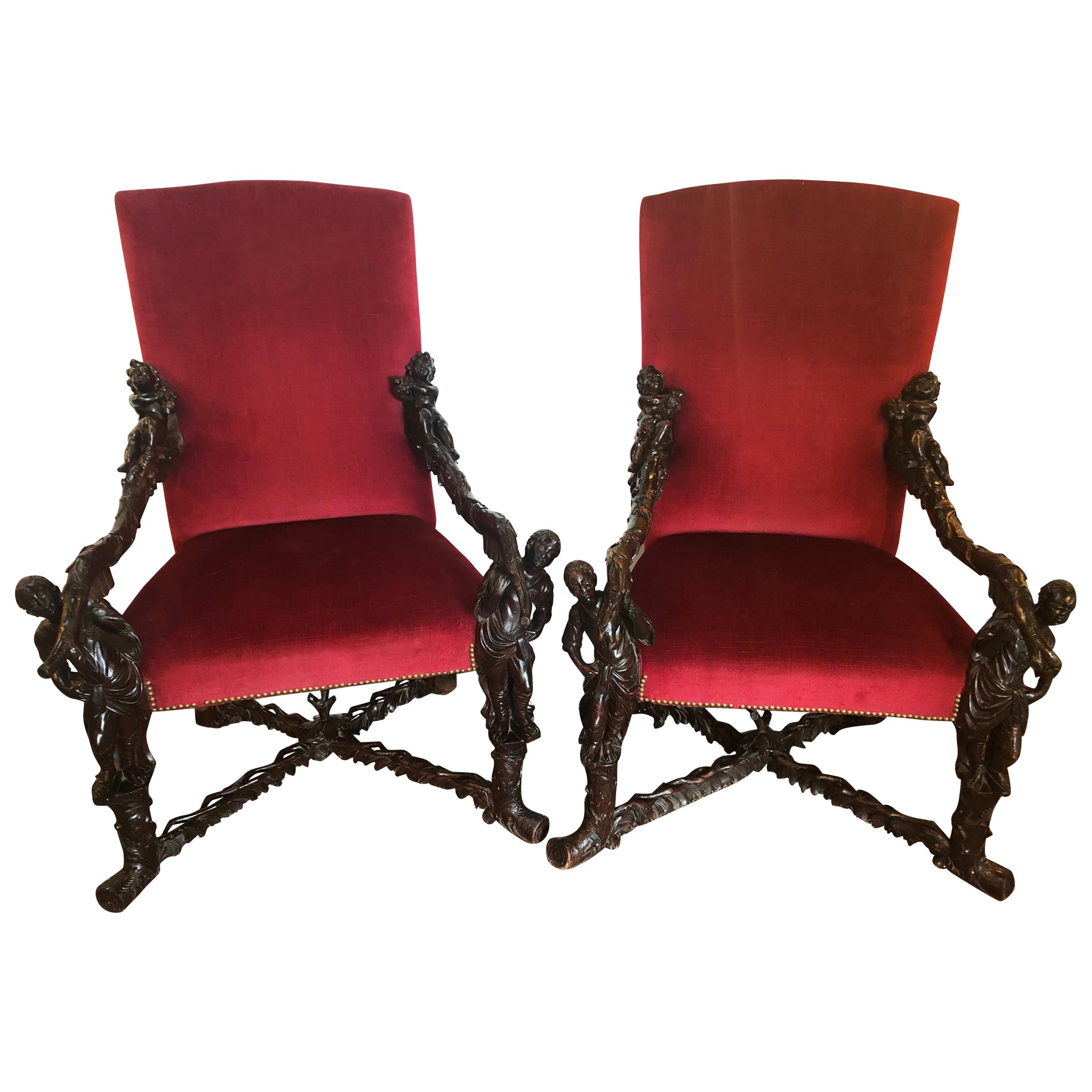Items Similar to Pair of Palatial Venetian Walnut Carved Mid-19th Century Baroque Figural Thrones
Want more images or videos?
Request additional images or videos from the seller
1 of 11
Pair of Palatial Venetian Walnut Carved Mid-19th Century Baroque Figural Thrones
About the Item
A very fine pair of palatial Venetian walnut carved mid-19th century Baroque figural throne armchairs, attributed to Valentino Panciera Besarel (Venice, 1829-1902) in the manner of Andrea Brustolon (1662-1732). The ornately carved thrones, each flanked with figures of standing males supporting a branch-carved armrests with vines. Raised on cabriolet scrolled legs. Provenance: The Castello di Giove in Umbria, Italy, circa 1870-1880.
Height: 54 1/4 inches (137.8 cm.)
Width: 37 1/4 inches (94.6 cm.)
Depth: 32 inches (81.3 cm.)
Andrea Brustolon (20 July 1662 – 25 October 1732) was an Italian sculptor in wood. He is known for his furnishings in the Baroque style and devotional sculptures.
Biography
He was trained in a vigorous local tradition of sculpture in his native Belluno, in the Venetian terraferma, and in the studio of the Genoese sculptor Filippo Parodi, who was carrying out commissions at Padua and at Venice (1677). He spent the years 1678-80 at Rome, where the High Baroque sculpture of Bernini and his contemporaries polished his style. Apart from that, the first phase of Brustolon's working career was spent in Venice, 1680–1685. Brustolon is documented at several Venetian churches where he executed decorative carving in such profusion that he must have quickly assembled a large studio of assistants. As with his contemporary in London, Grinling Gibbons almost all the high quality robust Baroque carving in Venice has been attributed to Brustolon at one time or another. In the Venetian Ghetto, at the Scola Levantina, Brustolon provided the woodwork for the synagogue on the piano nobile, where the carved, canopied bimah is supported on Solomonic columns, which Brustolon had seen in Bernini's baldacchino in the Basilica of St Peter's.
His furniture included armchairs with figural sculptures that take the place of front legs and armrest supports, inspired by his experience of Bernini's Cathedra Petri. The gueridon, a tall stand for a candelabrum, offered Brustolon unhampered possibilities for variations of the idea of a caryatid or atlas: the familiar Baroque painted and ebonized figural gueridons, endlessly reproduced since the eighteenth century, found their models in Brustolon's work.
His secular commissions from Pietro Venier, of the Venier di San Vio family (a suite of forty sculptural pieces that can be seen in the Sala di Brustolon of the Ca' Rezzonico, Venice), from the Pisani of Strà, and from the Correr di San Simeone families encourage the attribution to him of some extravagantly rich undocumented moveable furniture. Andrea Brustolon's elaborate carved furniture aspired towards the condition of sculpture, such as the Dutch bases for console tables which look like enlargements of the work of the two Van Vianens, Paulus and Adam, perhaps the greatest Dutch silversmiths of the period. These carved pieces display the baroque tendency to develop a form three-dimensionally in space.
Brustolon's walnut, boxwood and ebony pieces transcend ordinary functional limitations of furniture; they are constructed of elaborately carved figures. The framework of Brustolon's chairs, side tables and gueridons were carved as gnarled tree branches, with further supports of putti and male figures carved in ebony. Backrests of the chairs, which were never touched in the rigidly upright posture that contemporary etiquette demanded, were carved with allegories of vanity, fire and music, etc.
The most extravagant piece delivered for Pietro Venier was a large side table and vase-stand of box and ebony, designed as a single ensemble to display rare imported Japanese porcelain vases. The eclectic allegories include Hercules with the Hydra and Cerberus, males and reclining river-gods (see ref.).
For the Correr, less extrovert chairs bear female nudes extended along the armrests. For the Pisani, he carved a suite of twelve chairs (now at the Palazzo Quirinale) with flowers, fruit, leaves and branches to symbolize the twelve months of the year. Work by Brustolon is at the Villa Pisani at Stra.
In 1685 Brustolon returned to the house where he was born at Belluno, and from that time devoted himself mainly to tabernacles and devotional sculptures in walnut, boxwood or ivory. His polychromed ivory Corpus from a crucifix is in the Museo Civico di Belluno, which preserves some of Brustolon's preparatory drawings for frames to be carved with putti displaying emblems. A pair of boxwood sculptures, The Sacrifice of Abraham and Jacob Wrestling with the Angel, integral with scrolling barocchetto stands, were in the collection of Justus Liebig (Liebigshaus, Frankfort). An altarpiece, c. 1720, is at the Victoria and Albert Museum, London.
He died in Belluno in 1732.
Valentino Panciera Besarel (1829-1902) was Andrea Brustolon's great heir of the Nineteenth Century in wood carving; he presented himself as Brustolon's natural successor and alter ego. He studied from 1855 to 1857 in Venice and his career developed the most in there and in Belluno, although it was also turned to countries beyond the Alps. He applied in furniture and in ecclesiastical and secular decoration, showing his talents in furniture and frames making.
References:
Catalogue by Massimo de Grassi, Valentino Panciera Besarel, Verona, 2002) and was the subject of a monograph, Giovanni Angelini, Gli Scultori Panciera Besarel (Belluno 2002).
Biasuz G., and Buttignon M.G., 1969. Andrea Brustolon (Istituto Veneto Arti Grafiche) 1969
Gonzales-Palacios, Alvar, 1967. Il mobilio del '700 veneto
Semenzato, G., 1967. La scultura veneta del Seicento e del Settecento (Turin: Alfieri)
Valcanover, F., 1960. Indice delle opere d'arte della città e provincia di Belluno (Venice)
Biasuz, G., and E. Lacchin, 1928. Brustolon, preface by U. Ometti (Venice: Zanetti).
- Attributed to:Valentino Besarel (Workshop/Studio)
- Dimensions:Height: 54.25 in (137.8 cm)Width: 37.25 in (94.62 cm)Depth: 32 in (81.28 cm)Seat Height: 22 in (55.88 cm)
- Sold As:Set of 2
- Style:Baroque (In the Style Of)
- Materials and Techniques:
- Place of Origin:
- Period:
- Date of Manufacture:circa 1870-1880
- Condition:Repaired: Some minor repairs to carvings. Wear consistent with age and use. Minor losses. Minor fading. The frame and carving in great original condition with minor chipping and losses. There is some rubbing/fading on the armrests due to use. A few old pin-holes. The leather is worn and ripped, it should be replaced. Very sturdy and heavy frames.
- Seller Location:Los Angeles, CA
- Reference Number:
About the Seller
5.0
Vetted Seller
These experienced sellers undergo a comprehensive evaluation by our team of in-house experts.
Established in 1982
1stDibs seller since 2016
114 sales on 1stDibs
Typical response time: <1 hour
- ShippingRetrieving quote...Ships From: Los Angeles, CA
- Return PolicyThis item cannot be returned.
More From This SellerView All
- In Manner of Andrea Brustolon Venetian 19th Century Carved Walnut Figural ThroneBy Valentino Panciera BesarelLocated in Los Angeles, CAA fine Italian 19th century baroque revival style carved walnut figural throne armchair, attributed to Valentino Panciera Besarel (Venice, 1829-1902) in the manner of Andrea Brustolo...Category
Antique Late 19th Century Italian Baroque Revival Armchairs
MaterialsTapestry, Walnut
- In Manner of Andrea Brustolon Venetian 19th Century Carved Walnut Figural ThroneBy Andrea Brustolon, Valentino BesarelLocated in Los Angeles, CAA fine Italian 19th century Baroque style carved walnut figural throne armchair, attributed to Valentino Panciera Besarel (Venice, 1829-1902) in the manner of Andrea Brustolon...Category
Antique 19th Century Italian Baroque Armchairs
MaterialsFabric, Walnut
- Fine French 19th Century Louis XIV Style Baroque Carved Walnut Throne ArmchairLocated in Los Angeles, CAA fine French 19th century Louis XIV style Baroque Revival carved walnut throne armchair. The upholstered back and seat frame with open scrolled and carved armrests with carvings of ...Category
Antique Late 19th Century French Baroque Revival Armchairs
MaterialsFabric, Walnut
- Pair of 19th Century Baroque Revival Style Carved Walnut Throne ArmchairsLocated in Los Angeles, CAA fine pair of Italian 19th century Baroque Revival style carved walnut throne armchairs. The high-back frames with recent upholstered back and seat and open carved scrolled armrests...Category
Antique 19th Century Italian Baroque Revival Armchairs
MaterialsFabric, Walnut
- Pair of French 19th-20th Century Baroque Style Carved Thrones ArmchairsLocated in Los Angeles, CAA pair of French 19th-20th century Baroque style carved walnut and needlepoint upholstered hall throne armchairs with raised carved armrests and fluted conjoint legs. The tapestries ...Category
Antique 1890s French Baroque Armchairs
MaterialsWool, Walnut
- Pair of Italian 19th-20th Century Baroque Style Walnut Carved Throne ArmchairsLocated in Los Angeles, CAA fine pair of Italian 19th-20th century Baroque Revival style walnut figural carved high-back throne armchairs, each upholstered in a floral cream silk and gold fabric...Category
Antique Early 1900s Italian Baroque Revival Armchairs
MaterialsFabric, Walnut
You May Also Like
- 19th Century Italian Baroque Carved Walnut Throne ChairLocated in Sheffield, MAA richly carved walnut Italian throne chair. This arm chair could make a wonderful statement in any room. Use it for a desk chair, next to a fireplace, an office or in the living roo...Category
Antique 19th Century European Baroque Armchairs
MaterialsLeather, Walnut
- Pair of Italian 19th Century Baroque Carved Arm Throne Chairs, Figural CarvingsLocated in Stamford, CTPair of Italian 19th century Baroque carved arm throne chairs. The pair with figural carvings and putti sleeping on beds of leafs, attributed to Valentino Panciera Besarel (Venice, 1829-1902) in the manner of Andrea Brustolon (1662-1732). The ornately carved thrones, each flanked with figures of standing males supporting a branch-carved armrests with vines. Raised on cabriolet scrolled legs. Andrea Brustolon (20 July 1662–25 October 1732) was an Italian sculptor in wood. He is known for his furnishings in the Baroque style and devotional sculptures. Biography He was trained in a vigorous local tradition of sculpture in his native Belluno, in the Venetian terraferma, and in the studio of the Genoese sculptor Filippo Parodi, who was carrying out commissions at Padua and at Venice (1677). He spent the years 1678-1680 at Rome, where the High Baroque sculpture of Bernini and his contemporaries polished his style. Apart from that, the first phase of Brustolon's working career was spent in Venice, 1680–1685. Brustolon is documented at several Venetian churches where he executed decorative carving in such profusion that he must have quickly assembled a large studio of assistants. As with his contemporary in London, Grinling Gibbons almost all the high quality robust Baroque carving in Venice has been attributed to Brustolon at one time or another. In the Venetian Ghetto, at the Scola Levantina, Brustolon provided the woodwork for the synagogue on the piano nobile, where the carved, canopied bimah is supported on Solomonic columns, which Brustolon had seen in Bernini's baldacchino in the Basilica of St Peter's. His furniture included armchairs with figural sculptures that take the place of front legs and armrest supports, inspired by his experience of Bernini's Cathedra Petri. The gueridon, a tall Stand for a candelabrum, offered Brustolon unhampered possibilities for variations of the idea of a caryatid or atlas: the familiar Baroque painted and ebonized figural gueridons, endlessly reproduced since the 18th century, found their models in Brustolon's work. His secular commissions from Pietro Venier, of the Venier di San Vio family (a suite of forty sculptural pieces that can be seen in the Sala di Brustolon of the Ca' Rezzonico, Venice), from the Pisani of Strà, and from the Correr di San Simeone families encourage the attribution to him of some extravagantly rich undocumented moveable furniture. Andrea Brustolon's elaborate carved furniture aspired towards the condition of sculpture, such as the Dutch bases for console tables which look like enlargements of the work of the two Van Vianens, Paulus and Adam, perhaps the greatest Dutch silversmiths of the period. These carved pieces display the Baroque tendency to develop a form three-dimensionally in space. Brustolon's walnut, boxwood and ebony pieces transcend ordinary functional limitations of furniture; they are constructed of elaborately carved figures. The framework of Brustolon's chairs, side tables and gueridons were carved as gnarled tree branches, with further supports of putti and male figures carved in ebony. Backrests of the chairs, which were never touched in the rigidly upright posture that contemporary etiquette demanded, were carved with allegories of vanity, fire and music, etc. The most extravagant piece delivered for Pietro Venier was a large side table and vase-stand of box and ebony, designed as a single ensemble to display rare imported Japanese porcelain vases. The eclectic allegories include Hercules with the Hydra and Cerberus, males and reclining river-gods (see ref.). For the Correr, less extrovert chairs bear female nudes extended along the armrests. For the Pisani, he carved a suite of twelve chairs (now at the Palazzo Quirinale) with flowers, fruit, leaves and branches to symbolize the twelve months of the year. Work by Brustolon is at the Villa Pisani at Stra. In 1685 Brustolon returned to the house where he was born at Belluno, and from that time devoted himself mainly to tabernacles and devotional sculptures in walnut, boxwood or ivory. His polychromed ivory Corpus from a crucifix is in the Museo Civico di Belluno, which preserves some of Brustolon's preparatory drawings for frames to be carved with putti displaying emblems. A pair of boxwood sculptures, The Sacrifice of Abraham and Jacob Wrestling with the Angel...Category
Antique 1890s Italian Baroque Armchairs
MaterialsWood
- Italian Baroque Silver Mecca Giltwood Throne Armchair, Rome 17th CenturyLocated in Firenze, ITThis antique Italian Rococo 17th century throne armchair sourced in a palazzo in Rome, features swirls, curls and foliate motif richly hand carved...Category
Antique 17th Century Italian Baroque Armchairs
MaterialsSilver Leaf
- Pair of 19th-20th Century Louis XVI Style Carved ArmchairsBy Gianni VersaceLocated in Stamford, CTPair of 19th-20th century Louis XVI style finely carved armchairs in Gianni Versace Fabric. These spectacular one of a kind antique walnut fauteuils or ...Category
Early 20th Century French Louis XVI Armchairs
MaterialsWood
- Sicilian Sculpted Armchair Baroque Rococo Italy Throne Shell Walnut Linen VelvetLocated in Ettlingen, DEAuthentic Southern Italian, Sicilian throne, as it has been traditionally used in the large rural estates for the padrone, for the noble chief. Seating height would be perfect for a modern writing desk. The seating upholstery is quite firm, giving a good support. The carvings depicting the rising sun on top, the sea, and acanthus for a long life. The armchair can be dated around 1715. Carefully restored. All the carvings are complete, and fully original. Upholstered with an exclusive linen velvet by Maison Charles Burger...Category
Antique Early 18th Century Italian Baroque Armchairs
MaterialsLinen, Walnut
- Pair of 19th Century Carved and Paint Decorated Lyre Back ArmchairsLocated in Bridgeport, CTItalian or French in the Louis XVI style. Originally carved dark wood in later deep gray paint overall. The square backs with ribbon and beaded crest rails and wide carved lyres deco...Category
Antique 19th Century European Neoclassical Armchairs
MaterialsWood
Recently Viewed
View AllMore Ways To Browse
Baroque Country
Antique Furniture Emblems
Ornate Baroque
Carved Piece Woodwork
Black Baroque Frame
Mid Century Piano
Antique Furniture Living Room Ideas
19th C Side Chairs
Carved Painted Venetian
Carved Figural Wood Table
Mid Century Italian Drawing Room Furniture
Ebony Legs Mid Century
Black Bear Leather
Japanese Carved Flower
Midcentury Chairs From Japan
4 Columns Carved
A Pair Of Ebonized Armchairs
Leather Recliner Mid Century





